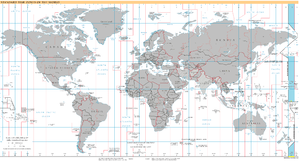UTC−12:00
| UTC−12:00 | |
|---|---|
| Time zone | |
 World map with the time zone highlighted | |
| UTC offset | |
| UTC | UTC±00:00 |
| Current time | |
| 08:58, 6 August 2024 UTC−12:00 [refresh] | |
| Observance of DST | |
| DST is observed throughout this time zone. | |

UTC−12:00 is a time offset that subtracts 12 hours from Coordinated Universal Time (UTC). It is the last to celebrate a New Year, and it is sometimes referred to as the International Date Line West time zone (IDLW).[1]
As standard time (all year round)
Oceania
- United States
- Baker Island and Howland Island (uninhabited islands belonging to the United States)
UTC−12 is a nautical time zone comprising the high seas between 180° and 172°30′W longitude, and the time is obtained by subtracting twelve hours from Coordinated Universal Time. Ships using this time are the last to begin each calendar day.
Characteristics of the time zone that observes UTC−12
A number of inhabited islands lie within the longitudinal limits of this time zone, but none of them keeps the date and time of UTC−12. Instead, they keep the time and date (or just the date) of one of the neighbouring zones, usually because they belong, politically, to an island group whose other members lie mostly in the neighbouring time zone.
Since the International Date Line West (IDLW) time zone represents the last place on Earth where a particular date exists before rolling over to the next date, it is sometimes used for deadlines and referred to as Anywhere on Earth (AoE). This means that if the deadline has not passed in the UTC–12 zone, the deadline has not yet passed.[1]
See also
- Greenwich Mean Time
- Howland and Baker islands
- UTC+12:00
- UTC+14:00, the first time zone to start a new day
References
- ^ a b "IEEE 802.16 AOE Deadline Documentation". IEEE 802 LAN/MAN Standards Committee. Retrieved 1 January 2018.
